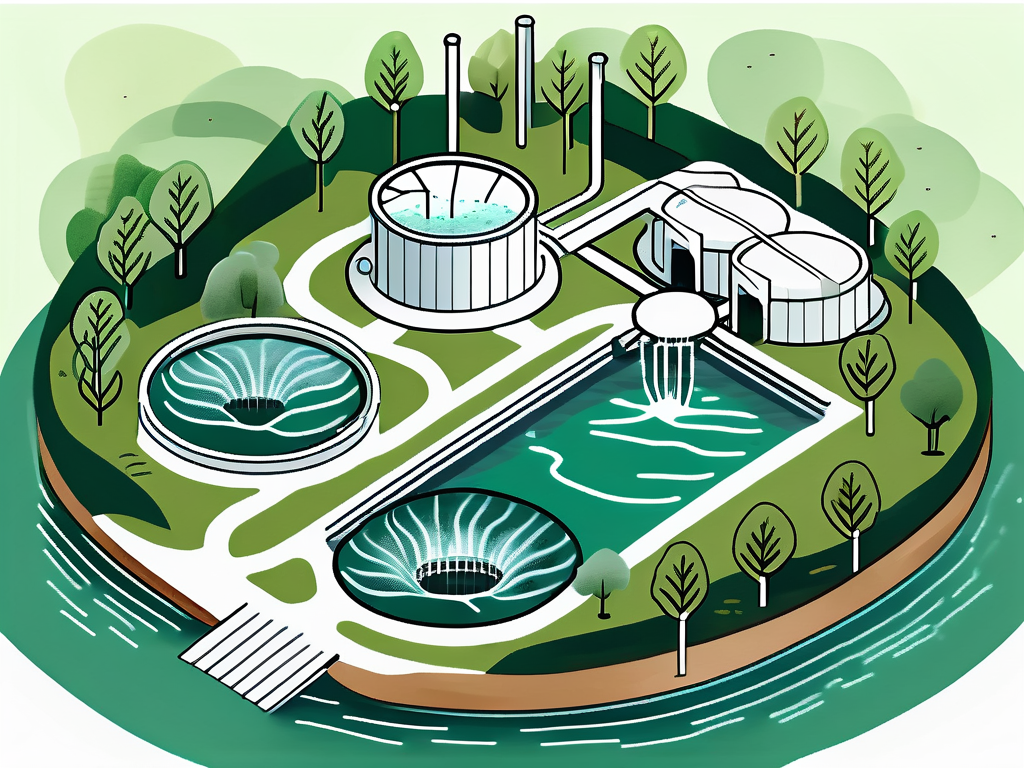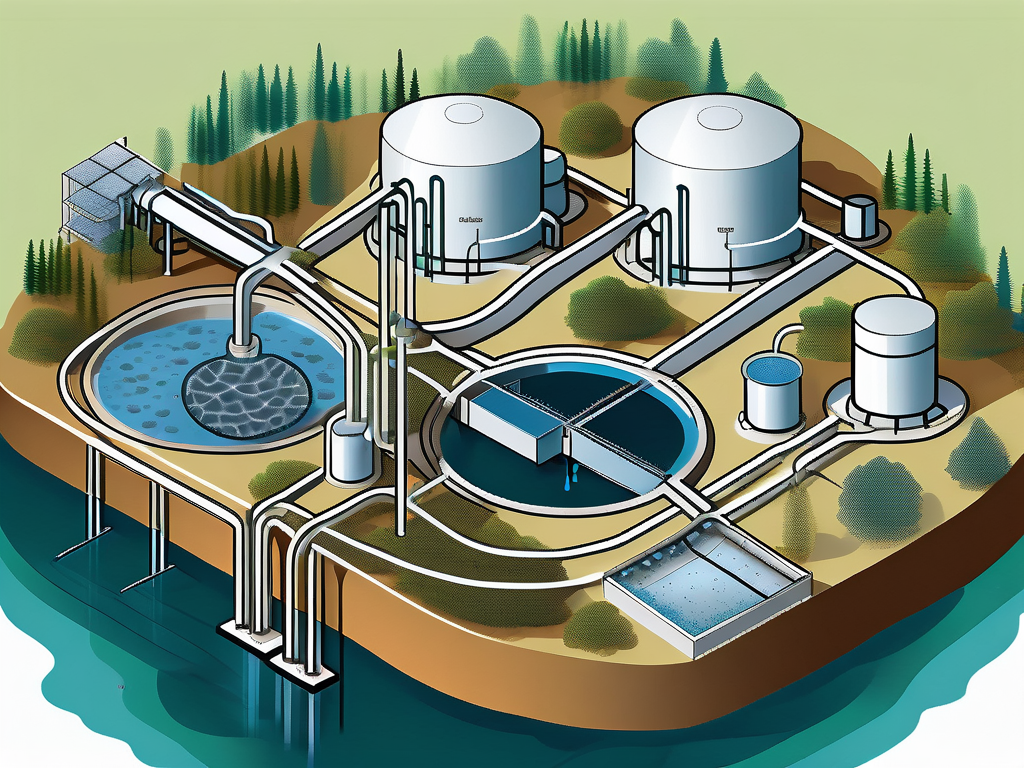
Clarification: Wastewater Treatment Explained
Wastewater treatment is a critical process that involves the removal of contaminants from wastewater to make it safe for release back into the environment. This glossary article aims to provide an in-depth understanding of the various stages, techniques, and terminologies associated with wastewater treatment.
Wastewater treatment is a complex process that involves a combination of physical, chemical, and biological methods to remove pollutants and contaminants. The process is designed to produce an effluent that will do as little harm as possible when discharged to the surrounding environment, and to prevent pollution.
Introduction to Wastewater Treatment
The primary goal of wastewater treatment is to reduce the amount of pollutants in the water to a level that is safe for discharge into the environment. This is achieved through a series of treatment processes that remove both organic and inorganic materials, kill pathogenic organisms, and decompose complex organic substances.

Wastewater treatment is a critical component of water management and plays a vital role in protecting public health and the environment. By treating wastewater, we can prevent the spread of disease, protect water resources, and ensure that our waterways remain clean and healthy.
Types of Wastewater
There are several types of wastewater, each requiring different treatment methods. These include municipal wastewater, which comes from homes and businesses; industrial wastewater, which comes from manufacturing and industrial processes; and agricultural wastewater, which comes from farming activities.
Each type of wastewater contains different types of pollutants and contaminants. For example, municipal wastewater may contain human waste, food scraps, oils, and soaps, while industrial wastewater may contain heavy metals, chemicals, and other hazardous substances. Agricultural wastewater may contain pesticides, fertilizers, and animal waste.
Importance of Wastewater Treatment
Wastewater treatment is essential for protecting public health and the environment. Untreated wastewater can contain harmful bacteria, viruses, and parasites that can cause disease in humans and animals. It can also contain nutrients that can cause excessive growth of algae in water bodies, leading to oxygen depletion and the death of aquatic life.
Furthermore, wastewater treatment helps to conserve water resources by allowing treated water to be reused for various purposes, such as irrigation, industrial processes, and even drinking water in some cases. This is particularly important in areas where water resources are scarce.
Stages of Wastewater Treatment
Wastewater treatment generally involves three stages: primary treatment, secondary treatment, and tertiary treatment. Each stage is designed to remove or reduce certain types of pollutants and contaminants.
It's important to note that not all wastewater treatment plants perform all three stages of treatment. The specific treatment processes used can vary depending on the type of wastewater being treated and the level of treatment required.
Primary Treatment
Primary treatment is the first stage of wastewater treatment and involves the removal of large, solid materials from the wastewater. This is typically achieved through a process of screening and sedimentation.
Screening involves passing the wastewater through screens to remove large objects, such as rags, sticks, and other debris. Sedimentation involves allowing the wastewater to sit in a tank or basin so that solid particles can settle to the bottom. The settled solids, known as sludge, are then removed for further treatment or disposal.
Secondary Treatment
Secondary treatment is the second stage of wastewater treatment and involves the removal of organic matter and suspended solids that were not removed during primary treatment. This is typically achieved through a process of biological treatment.
Biological treatment involves using microorganisms to break down organic matter in the wastewater. The microorganisms consume the organic matter as food, converting it into water, carbon dioxide, and energy. The remaining solids are then removed through a process of sedimentation.
Tertiary Treatment
Tertiary treatment is the final stage of wastewater treatment and involves the removal of any remaining pollutants that were not removed during primary and secondary treatment. This can include nutrients, such as nitrogen and phosphorus, and microorganisms, such as bacteria and viruses.
Tertiary treatment can involve a variety of processes, including filtration, disinfection, and nutrient removal. The specific processes used can vary depending on the quality of the effluent required and the intended use of the treated water.
Wastewater Treatment Techniques
There are numerous techniques used in the treatment of wastewater, each with its own advantages and disadvantages. The choice of technique depends on the type of wastewater being treated, the contaminants present, and the desired quality of the effluent.
Some common wastewater treatment techniques include activated sludge, trickling filters, rotating biological contactors, and membrane bioreactors. Each of these techniques uses different methods to remove contaminants and produce treated water that is safe for discharge or reuse.
Activated Sludge Process
The activated sludge process is a type of secondary treatment that uses microorganisms to break down organic matter in the wastewater. The process involves aerating the wastewater in a tank, which encourages the growth of microorganisms. These microorganisms consume the organic matter in the wastewater, converting it into water, carbon dioxide, and energy.
After aeration, the wastewater is allowed to settle in a secondary clarifier. The settled solids, known as activated sludge, are then returned to the aeration tank to continue the process. The remaining treated water is then discharged or sent for further treatment.
Trickling Filter Process
The trickling filter process is another type of secondary treatment that uses a bed of rocks, gravel, or plastic media to support the growth of microorganisms. Wastewater is sprayed over the bed and trickles down through the media. As it does so, the microorganisms consume the organic matter in the wastewater, breaking it down into water, carbon dioxide, and energy.
After passing through the trickling filter, the wastewater is collected and allowed to settle. The settled solids are then returned to the trickling filter to continue the process. The remaining treated water is then discharged or sent for further treatment.
Sludge Treatment and Disposal
The sludge that is produced during wastewater treatment must also be treated and disposed of in a safe and environmentally friendly manner. Sludge treatment involves reducing the volume of the sludge, stabilizing the organic matter, and disinfecting the sludge to kill any pathogenic organisms.
Once treated, the sludge can be disposed of in a number of ways, including landfilling, incineration, or application to land as a soil conditioner. The choice of disposal method depends on the quality of the sludge, local regulations, and the availability of disposal options.
Sludge Thickening and Dewatering
Sludge thickening involves reducing the volume of the sludge by removing some of the water. This can be achieved through a variety of methods, including gravity thickening, flotation thickening, and centrifugation.
Sludge dewatering further reduces the volume of the sludge by removing even more water. This is typically achieved through a process of filtration or centrifugation. The result is a semi-solid material that is easier and cheaper to transport and dispose of.
Sludge Stabilization and Disinfection
Sludge stabilization involves breaking down the organic matter in the sludge to reduce its potential to cause odors or attract flies. This is typically achieved through a process of digestion, either aerobic or anaerobic, which uses microorganisms to decompose the organic matter.
Sludge disinfection involves killing any pathogenic organisms in the sludge to make it safe for disposal or reuse. This can be achieved through a variety of methods, including heat treatment, chemical disinfection, and irradiation.
Advanced Wastewater Treatment Techniques
In some cases, more advanced treatment techniques may be required to remove certain contaminants or to produce a higher quality effluent. These advanced techniques can include membrane filtration, ion exchange, and advanced oxidation processes.

Advanced wastewater treatment techniques are typically more expensive and complex than conventional treatment techniques, but they can provide a higher level of treatment and can be necessary in certain situations.
Membrane Filtration
Membrane filtration involves passing the wastewater through a semi-permeable membrane to remove contaminants. The size of the pores in the membrane determines the size of the particles that can be removed. Membrane filtration can be used to remove suspended solids, bacteria, viruses, and some types of dissolved solids.
There are several types of membrane filtration, including microfiltration, ultrafiltration, nanofiltration, and reverse osmosis. Each type uses different pore sizes and pressures to achieve different levels of treatment.
Ion Exchange
Ion exchange involves passing the wastewater through a bed of resin that can exchange ions with the wastewater. This can be used to remove certain types of dissolved solids, such as heavy metals, from the wastewater.
The resin is typically regenerated after use by rinsing it with a solution of the desired ion. The spent regeneration solution, which contains the removed contaminants, must then be treated or disposed of in a safe manner.
Advanced Oxidation Processes
Advanced oxidation processes involve the use of strong oxidizing agents to break down organic and inorganic contaminants in the wastewater. These processes can be used to remove a wide range of contaminants, including organic compounds, heavy metals, and microorganisms.
There are several types of advanced oxidation processes, including ozone oxidation, hydrogen peroxide oxidation, and photocatalytic oxidation. Each type uses different oxidizing agents and conditions to achieve different levels of treatment.
Conclusion
Wastewater treatment is a complex process that involves a combination of physical, chemical, and biological methods to remove pollutants and contaminants. The goal is to produce an effluent that is safe for discharge into the environment and to prevent pollution.
While this glossary article provides a comprehensive overview of wastewater treatment, it is important to remember that the specific treatment processes used can vary depending on the type of wastewater being treated and the level of treatment required. As such, it is always important to consult with a wastewater treatment professional to determine the best treatment solution for a specific situation.



